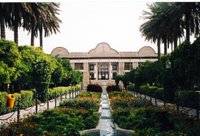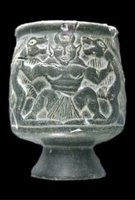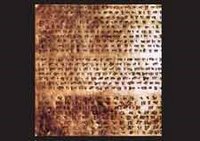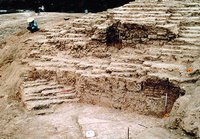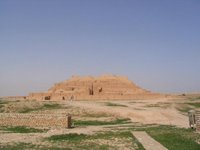Babak Khorramdin
Bābak Khorramdin ( بابک خرمدین ) is considered as one of the most heroic leaders of Iran who initiated the Khorramdinan, ( Those of the joyous religion), movement. This was a local freedom fighting movement aimed to over throw the Abbasid Caliphate who came to power after the Arab conquest of Iran.
Early Life:
Babak Khoramdin was born in the 8th century AC in Balal Abad region of Southern Az
 arbaijan, close to the city of Ardabil. His father died when he was in his teens and the responsibility of his 2 brothers and mother fell on his shoulders since. He became the protector of his family during a traditional Zoroastrian ceremony in a fire- temple which required him to wear a purple ribbon around his body and drink a glass of Azari wine. By age 18, Babak had already established himself in the city of Tabriz and was engaged in the arms trade and industry. His engagement in businesses gave him the opportunity to travel through out the Middle East, Caucasia and Eastern Europe. His travels familiarized him with the history, geography and the language of the regions.
arbaijan, close to the city of Ardabil. His father died when he was in his teens and the responsibility of his 2 brothers and mother fell on his shoulders since. He became the protector of his family during a traditional Zoroastrian ceremony in a fire- temple which required him to wear a purple ribbon around his body and drink a glass of Azari wine. By age 18, Babak had already established himself in the city of Tabriz and was engaged in the arms trade and industry. His engagement in businesses gave him the opportunity to travel through out the Middle East, Caucasia and Eastern Europe. His travels familiarized him with the history, geography and the language of the regions.Movement:
In the 8th century AC Iran was under the rule of Arabs Caliphs and hence unrest and resistance was growing in all the Iranian provinces. In 755, the ruling Caliph ordered the murder of Abu Muslim of Khorassan, who was a popular Persian nationalist especially among the Non- Muslims. His death provoked many Iranians to start revolts in different regions of the country in order to regain their freedom. This in turn, forced the Caliphs to use more violence against the Iranian population in order to keep the country under control. Moreover, Azarbaijan which was at the time the only Non-Muslim region in the country was constantly under the rav
 age of Bani Abbas ( the Caliph) to expand Islam further North. During this time, Azarbaijan defended itself through the leadership of Javanshir, who was the ruler of Azarbaijan at the time. Witnessing all this pressure being exerted on the people, Bābak joined the "Khurramiyyah (Khorram-Dinān)" movement in what later became known as Ghale-ye Bābak, meaning "Bābak Castle", located in the mountains of Qaradag. His knowledge of history, geography, and the latest battle tactics strengthened his position as a favorite candidate for commander during the early wars against the Arab occupiers. After a number of victories against the Arabs, Javanshir became severely injured and passed away, hence Babak took over power and married Javanshir's widow who introduced Babak to the Azari people as their leader. Bābak was a highly spiritual and educated person who respected his Zoroastrian heritage. He made every possible effort to bring Iranians together and also with leaders such as Afshin and Maziyar to form a united front against the Arab Caliph.
age of Bani Abbas ( the Caliph) to expand Islam further North. During this time, Azarbaijan defended itself through the leadership of Javanshir, who was the ruler of Azarbaijan at the time. Witnessing all this pressure being exerted on the people, Bābak joined the "Khurramiyyah (Khorram-Dinān)" movement in what later became known as Ghale-ye Bābak, meaning "Bābak Castle", located in the mountains of Qaradag. His knowledge of history, geography, and the latest battle tactics strengthened his position as a favorite candidate for commander during the early wars against the Arab occupiers. After a number of victories against the Arabs, Javanshir became severely injured and passed away, hence Babak took over power and married Javanshir's widow who introduced Babak to the Azari people as their leader. Bābak was a highly spiritual and educated person who respected his Zoroastrian heritage. He made every possible effort to bring Iranians together and also with leaders such as Afshin and Maziyar to form a united front against the Arab Caliph.One of the most dramatic periods in the history of Iran was set under Bābak’s leadership between 816-837. During these most crucial years, they not only fought against the Caliphate, but also against Arab language and culture. Eventually, Bābak, his wife, and his warriors were forced to leave Ghaleye Bābak after 23 years of constant campaigns. He was eventually betrayed by Afshin and was handed over to the Abbasid Caliph.
Babak's Execution:
During Bābak’s execution, the Caliph's henchmen first cut off his legs and hands in order to convey the most devastating message to his followers. Legend has it that Bābak bravely rinsed his face with the drained blood pouring out of his cuts, thus depriving the Caliph and the rest of the Abbasid army from seeing his pale face, a result of the heavy loss of blood.
Babak's Influence:
There are many speculations about the origin of Babak. Some believe he was an Azari Turk, but others believe that at this time, Turks had not yet migrated to Azarbaijan. Still others believe that he was Persian since his name is purely from Persian origins. Also he was a
 follower of Zoroastrian Persians and there has never been any proof supporting his Turkish background. No mater what region of Iran he was from, he was an Iranian freedom fighter. Babak’s sensational and legendary campaign to defend Iran's national identity and interest is still pursued after nearly 1200 years in Southern Azerbaijan every year on his birthday. Every year in July, Iranians pilgrims visiting Babak's Fortress to hail their Persian hero, Babak, as the symbol of Iranian resistance against foreign and dictatorship rules. The pilgrims reading poetry including Shahnameh (the Book of Kings - Iran’s most famous epic) and playing traditional Persian music. They also lit up bonfires to follow traditional rituals of ancient Iran.
follower of Zoroastrian Persians and there has never been any proof supporting his Turkish background. No mater what region of Iran he was from, he was an Iranian freedom fighter. Babak’s sensational and legendary campaign to defend Iran's national identity and interest is still pursued after nearly 1200 years in Southern Azerbaijan every year on his birthday. Every year in July, Iranians pilgrims visiting Babak's Fortress to hail their Persian hero, Babak, as the symbol of Iranian resistance against foreign and dictatorship rules. The pilgrims reading poetry including Shahnameh (the Book of Kings - Iran’s most famous epic) and playing traditional Persian music. They also lit up bonfires to follow traditional rituals of ancient Iran. 